AFRE Holds Its Annual Graduate Student Research Symposium
The winner of the award receives a $300 prize and is recognized at the AFRE Awards Ceremony.

Every year, several graduate students participate in the Department of Agricultural, Food and Resource Economics’ (AFRE) Research Symposium. The 2024 symposium took place on March 29 and provided an opportunity for 3rd year Ph.D. students in AFRE to share their research papers they have been working on through the guidance of their committees.
The 2024 symposium had seven students present there research covering topics which ranged from legislative actions on foreign holdings of U.S. agricultural land to irrigation adoption in the Danube river basin. Each student presenting was given 30-40 minutes to present their research followed by the remaining 20-30 minutes for questions from faculty and fellow AFRE graduate students.
The participants and their abstracts for their research included:
- Fernanda Alfaro-Gonzalez – “Changes in State Minimum Wage and the Price of Food Away from Home”
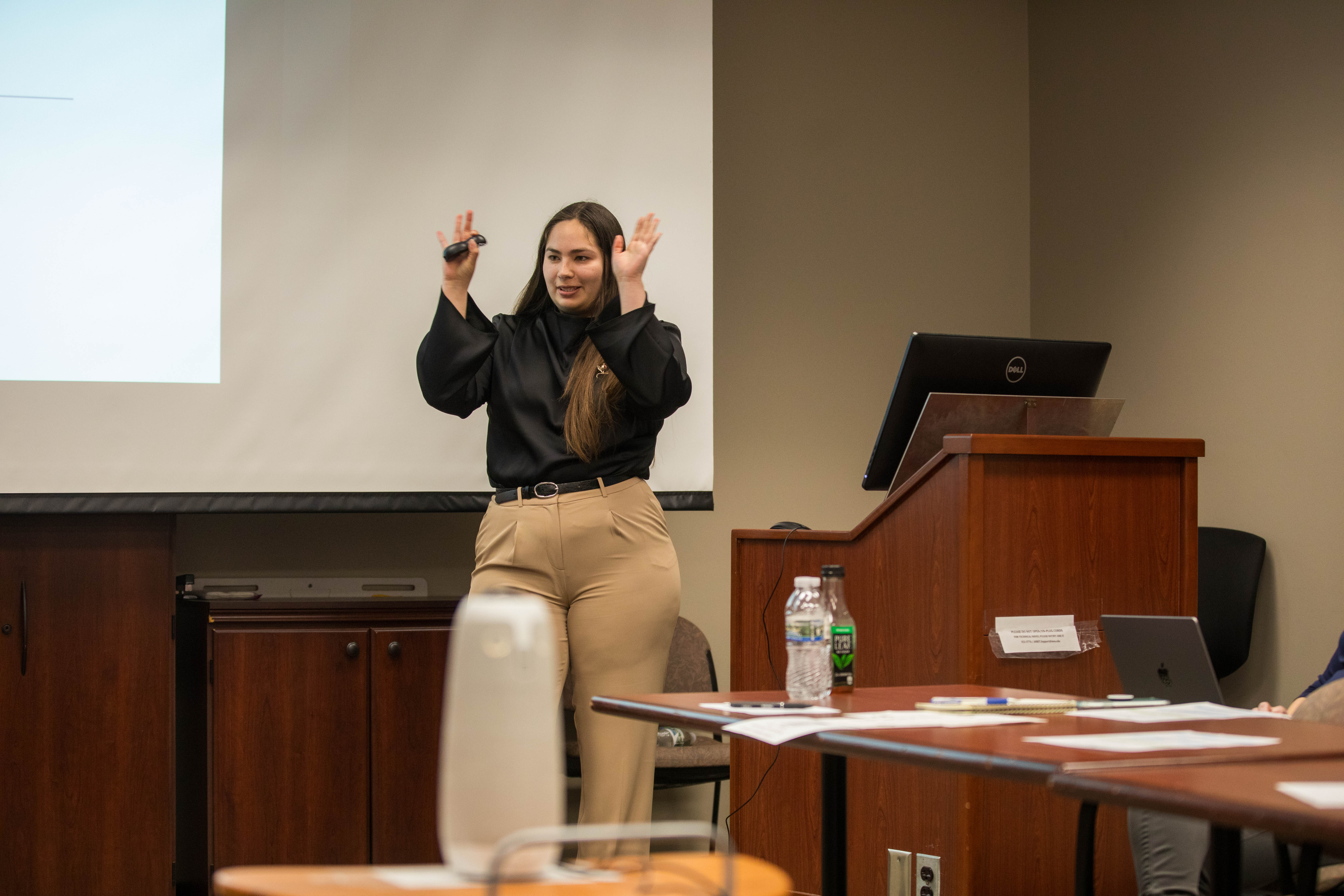 On January 1, 2023, after about two years of abnormally high inflation in the United States, 24
On January 1, 2023, after about two years of abnormally high inflation in the United States, 24
states simultaneously increased their minimum wage. Using this wage variation, we test two
hypotheses: i) the hourly minimum wage rise translated into higher labor costs and, increased food away from home prices; and ii) this cost pressure is transmitted across state lines. To study the effects of this policy change, we use data from a standardized food product, the Subway BLT 6-inch sandwich, whose price is primarily determined by franchise owners. We tracked the sandwich price changes across 19,170 restaurant locations nationwide between December 2022 and April 2023. Our findings reveal that, on average, the national price decreased during this period. However, the magnitude of the reduction was statistically lower in states that implemented the January 1 minimum wage hike. Furthermore, through a state border analysis, we find evidence in favor of a pass-through effect. We document noticeable differences in the behavior of sandwich prices for restaurants within three miles of the state border. We offer two contributions to the minimum wage and pass-through literature. First, we address a research gap on minimum wage spillover effects, specifically across state borders. Secondly, we contribute empirically to the passthrough literature by controlling for potential confounding factors by using a homogeneous food product and spatial boundaries to simulate a counterfactual analysis for the entire US. Finally, our results provide evidence to adjust food assistance programs at the state level.
- Sungmin Cheu – “Effects of Crop Insurance on Water Use: Mitigating Effects of Irrigation Costs”
 This study investigates the effect of crop insurance on water use for irrigation. Using crop-specific water use data and pumping costs to extract groundwater, we analyze the moral hazard behavior in water use and how this behavior varies depending on the pumping costs in the context of groundwater in regions overlying the High Plains Aquifer. We find that even after controlling for changes in crop mix and acreage, an increase in insurance participation raises per-acre water use. We also find that the moral hazard behavior increases as the pumping costs increase. These findings underscore that programs that increase water prices may lead to a further decrease in water use, inducing an indirect decrease in water use in addition to a direct price effect.
This study investigates the effect of crop insurance on water use for irrigation. Using crop-specific water use data and pumping costs to extract groundwater, we analyze the moral hazard behavior in water use and how this behavior varies depending on the pumping costs in the context of groundwater in regions overlying the High Plains Aquifer. We find that even after controlling for changes in crop mix and acreage, an increase in insurance participation raises per-acre water use. We also find that the moral hazard behavior increases as the pumping costs increase. These findings underscore that programs that increase water prices may lead to a further decrease in water use, inducing an indirect decrease in water use in addition to a direct price effect.
- Peyton Ellis – “Necessary but Not Sufficient: The Limitations of Empowerment Metrics in the Absence of a Gender Productivity Gap”
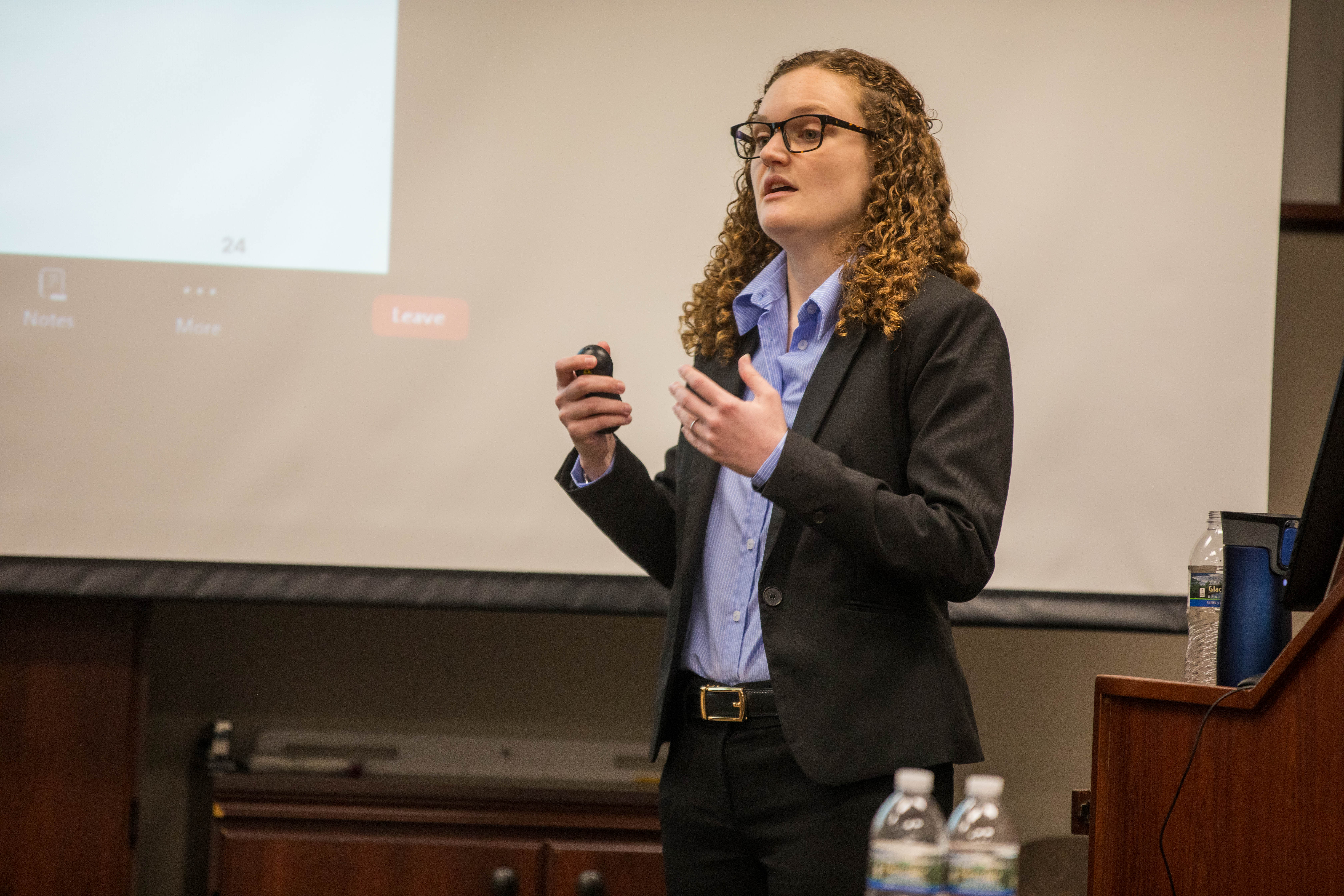 As the majority of research on gender productivity gaps has been conducted in the context of women being less empowered and productive, the connection between current empowerment metrics and productivity is only understood for this context. Thus, these studies may be inadvertently capturing external variables associated with gender, rather than directly measuring the impact of empowerment on productivity. This paper aims to fill this gap by exploring the strength of the relationship between current empowerment metrics and productivity using a dataset where there is no empowerment or productivity gap between women and men. To do so, a stochastic production frontier model is employed that allows for the comparison of models that incorporate empowerment metrics and those that do not. The findings of this analysis reflect that outside of the previously studied context, empowerment metrics do not add statistically significant explanatory power to the production model. Hence, the results imply that there are overarching social influences on an individual’s productivity outside of current empowerment metrics.
As the majority of research on gender productivity gaps has been conducted in the context of women being less empowered and productive, the connection between current empowerment metrics and productivity is only understood for this context. Thus, these studies may be inadvertently capturing external variables associated with gender, rather than directly measuring the impact of empowerment on productivity. This paper aims to fill this gap by exploring the strength of the relationship between current empowerment metrics and productivity using a dataset where there is no empowerment or productivity gap between women and men. To do so, a stochastic production frontier model is employed that allows for the comparison of models that incorporate empowerment metrics and those that do not. The findings of this analysis reflect that outside of the previously studied context, empowerment metrics do not add statistically significant explanatory power to the production model. Hence, the results imply that there are overarching social influences on an individual’s productivity outside of current empowerment metrics.
- Nahian Bin Khaled – “Long-Term Influence of Social Network and Peers' Characteristics on Agricultural Technology Adoption: Evidence from Tanzania”
 We study the long-term effects of social network and peer influences in driving technology adoption in the context of bean farming in Tanzania. We combine two popular farmer-level dissemination methods—demonstration plots and distribution of free trial packs by lead farmers—as our intervention of interest, both of which were implemented concurrently in the study area. In an observational setting, we leverage the variability in how the intervention was received within the randomly selected sample of farmers, for whom we have data on their information-sharing linkages with each of the other farmers in the sample. This unique data allows us to identify the effect of social networks by studying the specific mechanism of information transmission and employing an instrumental variable approach, in addition to a rich set of control variables. Using a post-intervention, three-round panel dataset spanned over four years, we observe that the social network effect on the extensive margin is absent one-year post-intervention but is observed in the third and fourth years after the intervention. Having a peer in the network who received the intervention significantly boosts the adoption of improved bean varieties, with a noticeably higher increase when the peer is identified as a risk-taker. This effect is even more pronounced in villages with a larger number of bean-growing farmers. However, we observed no significant change on the intensive margin. Our findings carry considerable policy implications for agricultural extension programs aimed at promoting the adoption of improved seed varieties in low-income countries.
We study the long-term effects of social network and peer influences in driving technology adoption in the context of bean farming in Tanzania. We combine two popular farmer-level dissemination methods—demonstration plots and distribution of free trial packs by lead farmers—as our intervention of interest, both of which were implemented concurrently in the study area. In an observational setting, we leverage the variability in how the intervention was received within the randomly selected sample of farmers, for whom we have data on their information-sharing linkages with each of the other farmers in the sample. This unique data allows us to identify the effect of social networks by studying the specific mechanism of information transmission and employing an instrumental variable approach, in addition to a rich set of control variables. Using a post-intervention, three-round panel dataset spanned over four years, we observe that the social network effect on the extensive margin is absent one-year post-intervention but is observed in the third and fourth years after the intervention. Having a peer in the network who received the intervention significantly boosts the adoption of improved bean varieties, with a noticeably higher increase when the peer is identified as a risk-taker. This effect is even more pronounced in villages with a larger number of bean-growing farmers. However, we observed no significant change on the intensive margin. Our findings carry considerable policy implications for agricultural extension programs aimed at promoting the adoption of improved seed varieties in low-income countries.
- Lin Lin – “Factors Predicting Restrictive State Legislative Actions on Foreign Holdings of U.S. Agricultural Land”
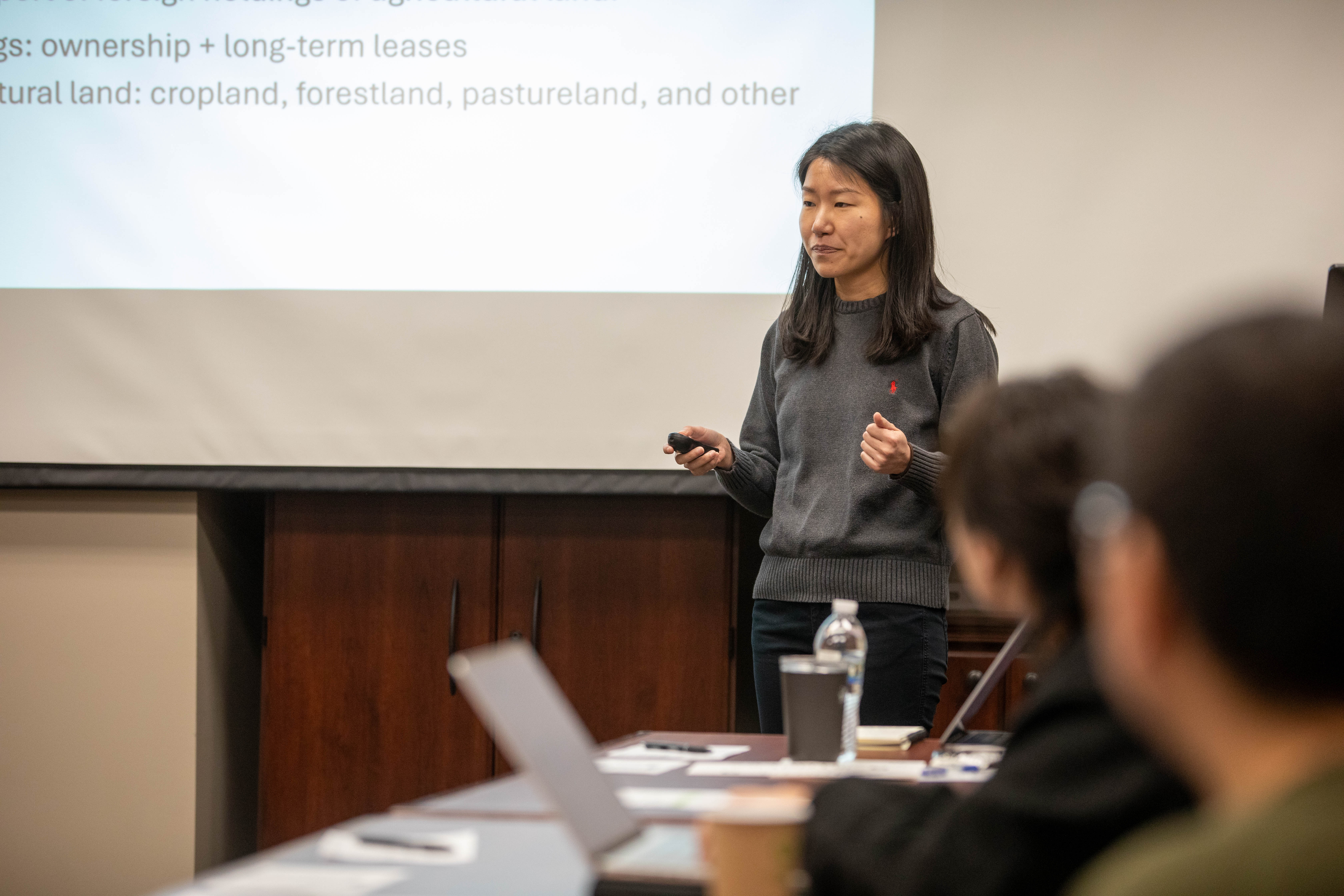 Foreign holdings of U.S. agricultural land have raised national and food security concerns. These concerns have been reflected in the significant amount of state legislative actions that seek to restrict foreign holdings of U.S. agricultural land in recent years. While there has not been clear evidence of the negative impacts of such foreign holdings, these restrictive legislations could deprive immigrants’ residential rights or lead to unintended economic consequences. This naturally leads to the question: what are the factors driving these controversial state legislative actions? This study informs this important issue by investigating factors predicting state legislators’ bill proposals and voting behavior by comparing results generated from two analytical methods. We further conduct an analysis at the state level, accounting for the sequential nature of state level activity, that allows us to capture the impacts of state agricultural, political, and trade characteristics. Results suggest that while consolidating state croplands and agricultural industry is one reason for restricting foreign interests, protecting state agricultural land from Chinese holdings is also part of the consideration. In addition, national security concerns raised by Chinese ownership in recent years could play a heavier role in these restrictive state legislative actions.
Foreign holdings of U.S. agricultural land have raised national and food security concerns. These concerns have been reflected in the significant amount of state legislative actions that seek to restrict foreign holdings of U.S. agricultural land in recent years. While there has not been clear evidence of the negative impacts of such foreign holdings, these restrictive legislations could deprive immigrants’ residential rights or lead to unintended economic consequences. This naturally leads to the question: what are the factors driving these controversial state legislative actions? This study informs this important issue by investigating factors predicting state legislators’ bill proposals and voting behavior by comparing results generated from two analytical methods. We further conduct an analysis at the state level, accounting for the sequential nature of state level activity, that allows us to capture the impacts of state agricultural, political, and trade characteristics. Results suggest that while consolidating state croplands and agricultural industry is one reason for restricting foreign interests, protecting state agricultural land from Chinese holdings is also part of the consideration. In addition, national security concerns raised by Chinese ownership in recent years could play a heavier role in these restrictive state legislative actions.
- Jiawen Liu – “Market Integration and Inter-market Connections: Evidence from Nigeria”
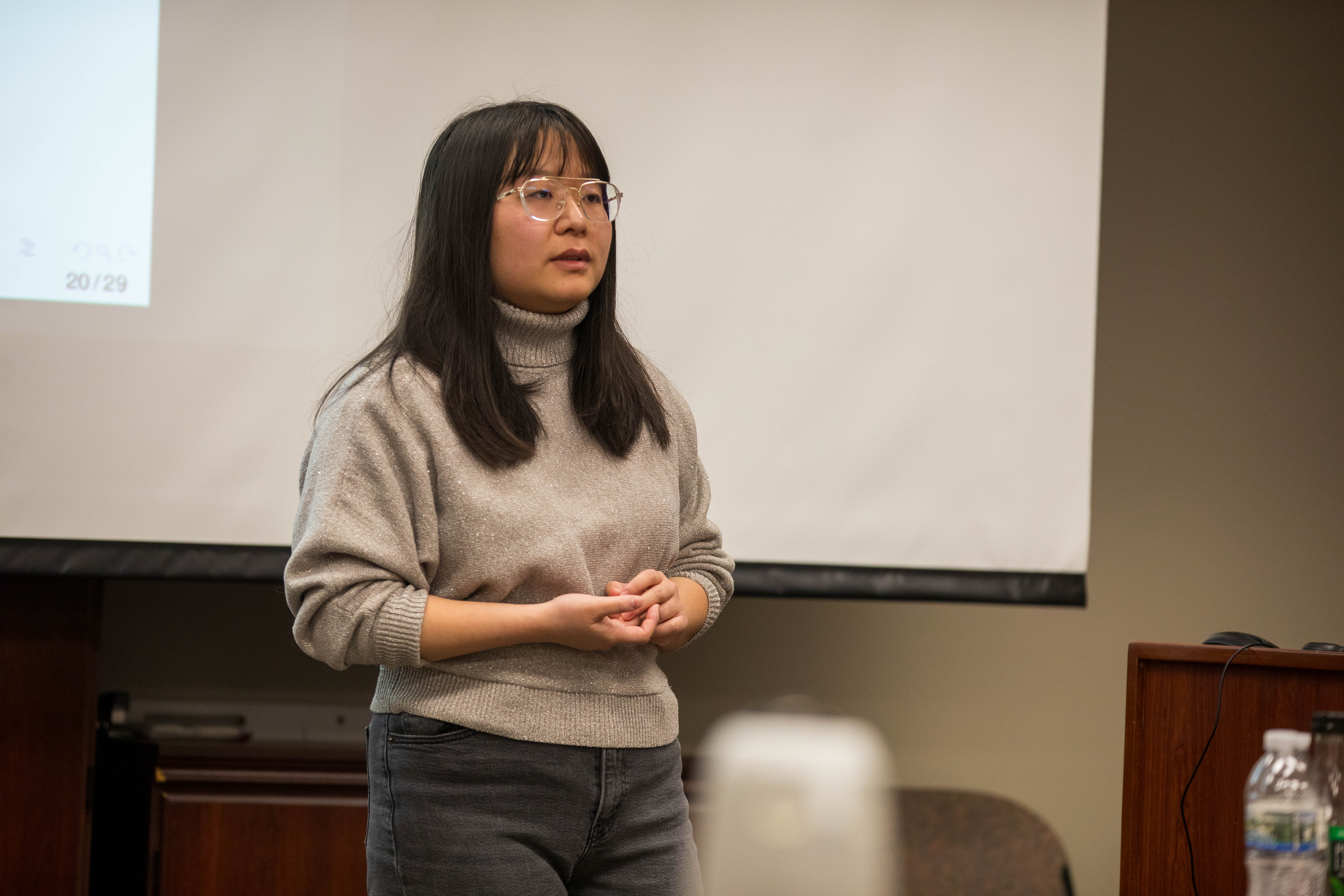 In developing economies, market integration is fundamental to achieving food security and economic stability, a necessity that becomes even more critical in the face of socio-political conflicts. Our study centers on the dynamics of trade between urban and rural areas and how violence events impact market integration. Using weekly data for key grain crops across 97 markets, we document the patterns of integration within rural-rural, urban-urban and urban-rural market pairs. Rural-to-rural networks show greater integration, suggesting that the country has effective intra-regional trade that potentially reduces reliance on urban centers. The finding is surprising, if one is not familiar with grain markets in Nigeria, where many of the trade hubs are rural. Moreover, we find that violence events along trade routes show no immediate impact on market integration that is statistically significant. In the long run, markets with troubled routes are less connected. The findings suggest that grain market networks are not only integrated, but are resilient in the face of short-run socio-political disruptions. The insights are relevant for policies that address food security through market integration.
In developing economies, market integration is fundamental to achieving food security and economic stability, a necessity that becomes even more critical in the face of socio-political conflicts. Our study centers on the dynamics of trade between urban and rural areas and how violence events impact market integration. Using weekly data for key grain crops across 97 markets, we document the patterns of integration within rural-rural, urban-urban and urban-rural market pairs. Rural-to-rural networks show greater integration, suggesting that the country has effective intra-regional trade that potentially reduces reliance on urban centers. The finding is surprising, if one is not familiar with grain markets in Nigeria, where many of the trade hubs are rural. Moreover, we find that violence events along trade routes show no immediate impact on market integration that is statistically significant. In the long run, markets with troubled routes are less connected. The findings suggest that grain market networks are not only integrated, but are resilient in the face of short-run socio-political disruptions. The insights are relevant for policies that address food security through market integration.
- Noormah Rizwan – “Are Farmers Adapting to Drier Conditions? Crop Choices and Irrigation Adoption in the Danube River Basin”
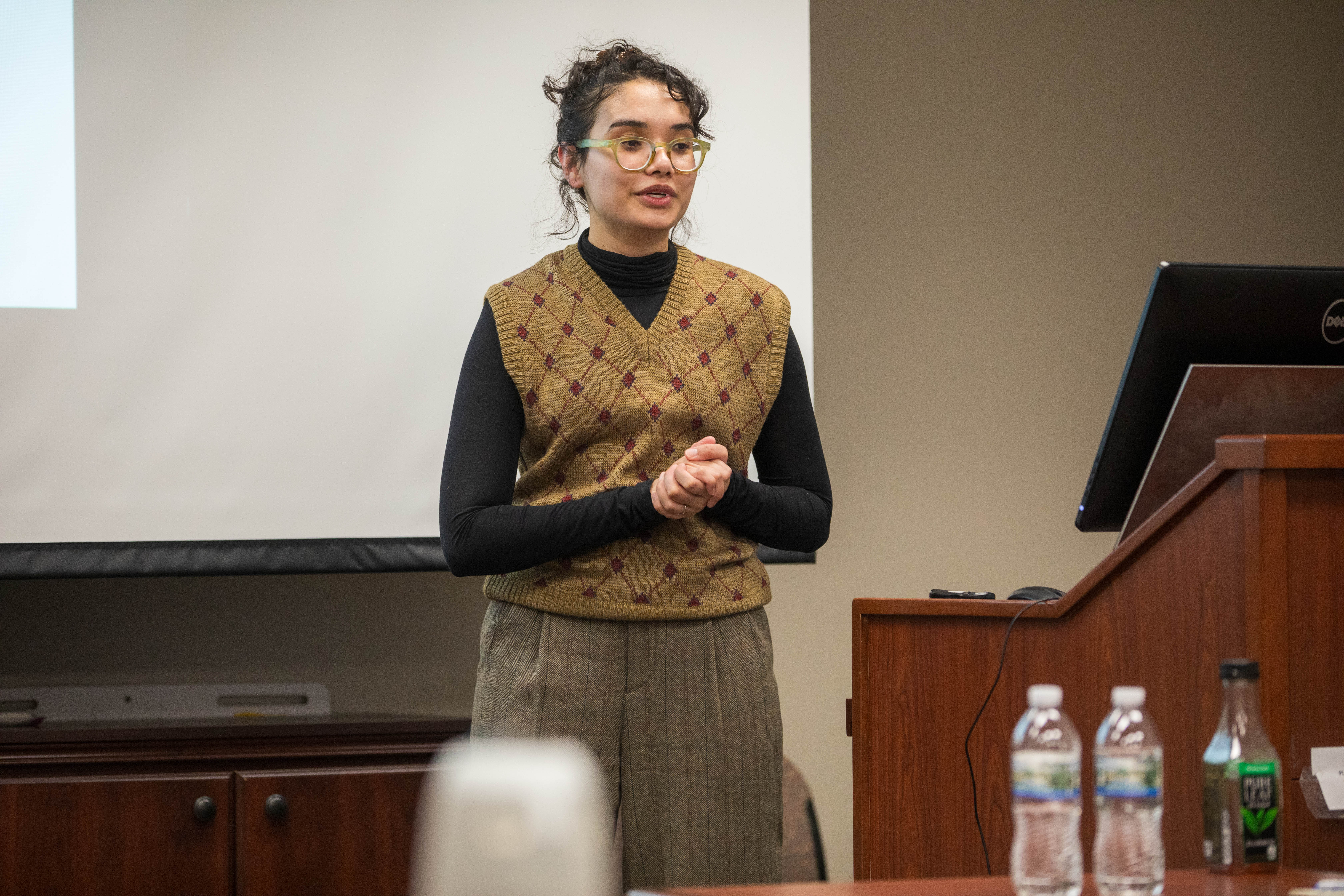 Under rising temperatures and increased variability in precipitation, farmers are often forced to adjust their crop choices to less water-intensive and drought-resistant crops. This crop substitution results in significant welfare implications for the farmers in terms of reductions in agricultural profits and income. To insure their income against the effects of climate change on crop choices, many farmers invest in mitigation strategies that allow them to stick to their cropping patterns. For example, investment in irrigation infrastructure allows farmers to continue planting water-intensive crops under drier conditions. Ignoring this level of adaptation overstates the effects that climate change has on farmers’ cropping decisions. In this paper, we aim to quantify the impact of short-term weather fluctuations on farmers’ crop choices while accounting for farmer-level adaptation. We set up conditional logit crop choice model using field-level data on six major crops planted across Serbia. We find significant evidence that irrigation access increases the likelihood of planting water-intensive maize, soybean, and sugar beet relative to less-water intensive crops. We also predict that at current-levels of irrigation adoption, drier conditions, triggered by an exogenous decline in soil moisture content, push farmers away from profitable, water-intensive spring crops to less profitable wheat. However, an exogenous decline in soil moisture content is likely to increase farmers’ propensity to adopt irrigation. We set up an irrigation adoption model to study the change in the probability of adopting irrigation in response to weather fluctuations. We find that short-term fluctuations in weather have a small but positive impact on irrigation adoption. Long term changes in temperature and soil moisture content affect the likelihood of adoption significantly. Our findings imply that models simulating impact of climate change on crop choices may exaggerate the effects if adaptation is not accounted for.
Under rising temperatures and increased variability in precipitation, farmers are often forced to adjust their crop choices to less water-intensive and drought-resistant crops. This crop substitution results in significant welfare implications for the farmers in terms of reductions in agricultural profits and income. To insure their income against the effects of climate change on crop choices, many farmers invest in mitigation strategies that allow them to stick to their cropping patterns. For example, investment in irrigation infrastructure allows farmers to continue planting water-intensive crops under drier conditions. Ignoring this level of adaptation overstates the effects that climate change has on farmers’ cropping decisions. In this paper, we aim to quantify the impact of short-term weather fluctuations on farmers’ crop choices while accounting for farmer-level adaptation. We set up conditional logit crop choice model using field-level data on six major crops planted across Serbia. We find significant evidence that irrigation access increases the likelihood of planting water-intensive maize, soybean, and sugar beet relative to less-water intensive crops. We also predict that at current-levels of irrigation adoption, drier conditions, triggered by an exogenous decline in soil moisture content, push farmers away from profitable, water-intensive spring crops to less profitable wheat. However, an exogenous decline in soil moisture content is likely to increase farmers’ propensity to adopt irrigation. We set up an irrigation adoption model to study the change in the probability of adopting irrigation in response to weather fluctuations. We find that short-term fluctuations in weather have a small but positive impact on irrigation adoption. Long term changes in temperature and soil moisture content affect the likelihood of adoption significantly. Our findings imply that models simulating impact of climate change on crop choices may exaggerate the effects if adaptation is not accounted for.
Lin Lin was recognized as having the best presentation of the research symposium. This is an award that is given annually following the Graduate Research Symposium. The winner of the award receives a $300 prize and is recognized at the AFRE Awards Ceremony. Lin was recognized at the AFRE Awards Ceremony on April 3, 2024.
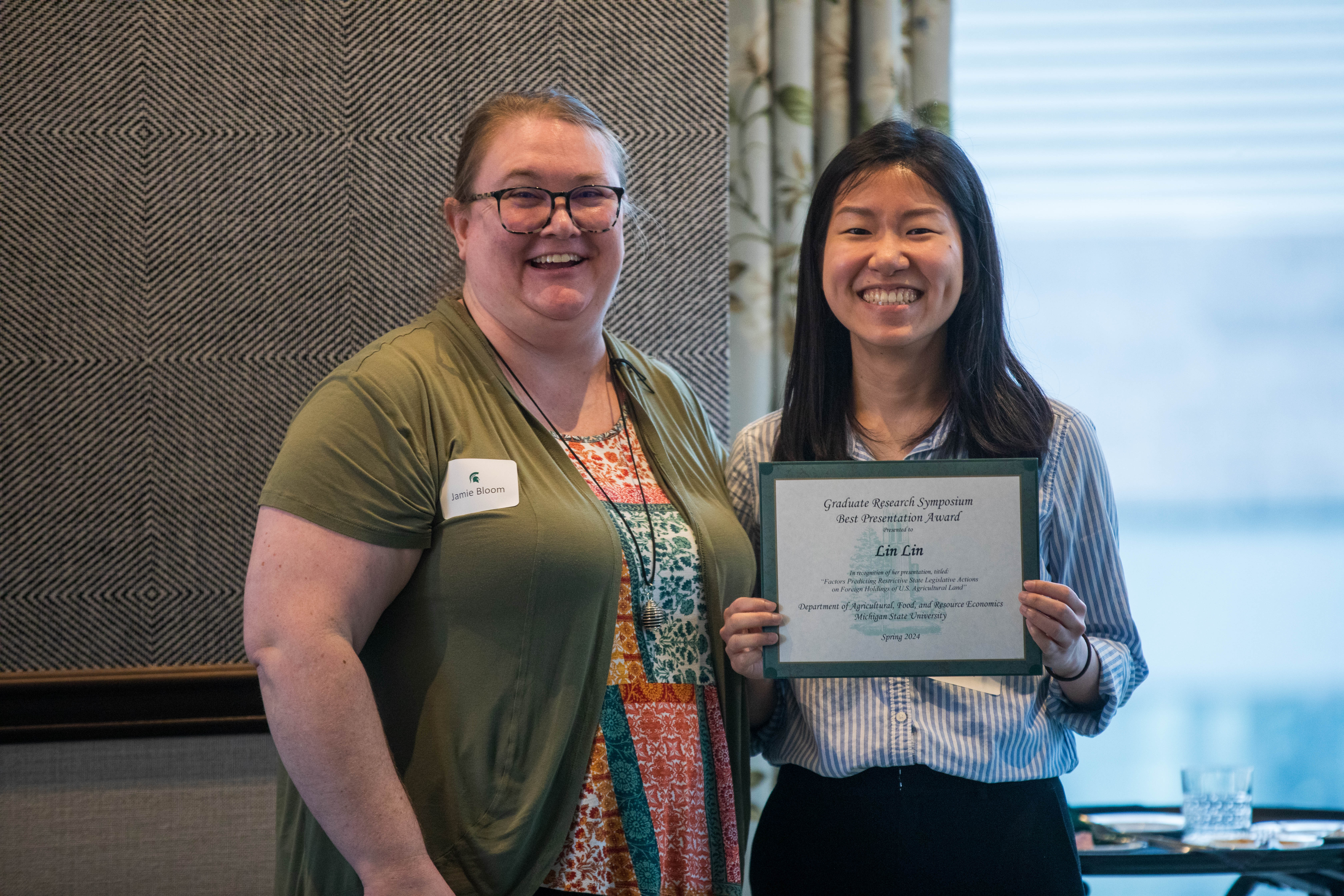



 Print
Print Email
Email




